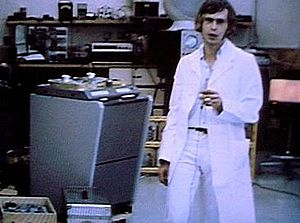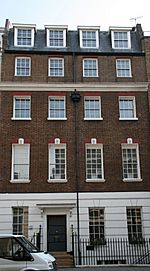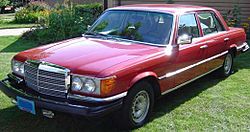Magic Alex facts for kids
Quick facts for kids
Magic Alex
|
|
|---|---|

Mardas in the Apple Electronics laboratory with some of the equipment he used
|
|
| Born |
Yannis Alexis Mardas
2 May 1942 Athens, Greece
|
| Died | 13 January 2017 (aged 74) Athens, Greece
|
| Other names | John Alexis Mardas |
| Occupation | Electronics engineer, security consultant |
| Board member of | Apple Electronics |
| Spouse(s) | Eufrosyne Doxiades |
Yannis (later John) Alexis Mardas (Greek: Αλέξης Μάρδας; 2 May 1942 – 13 January 2017), also known as Magic Alex, was a Greek electronics engineer who was closely associated with the Beatles. His nickname was given to him by John Lennon when he was involved with the group between 1965 and 1969, during which time he became head of Apple Electronics.
Mardas arrived in England in 1965, exhibiting his Kinetic Light Sculptures at the Indica Gallery. He impressed John Lennon with the Nothing Box: a small plastic box with randomly blinking lights, and allegedly claimed that he could build a 72-track tape machine. Mardas was in India with the Beatles at the Maharishi Mahesh Yogi's ashram in India and was then given the job of designing the new Apple Studio in Savile Row. His schemes lost Apple at least £300,000 (£3.75 million in 2021 pounds).
In the 1970s, the anti-terrorism industry offered bullet-proof vehicles, bugging devices and security hardware, so Mardas set up companies offering these products to VIPs. King Hussein of Jordan bought a fleet of cars that Mardas had customised, but then reportedly had the changes reversed when tests demonstrated them to be useless. In 1987, Mardas was a managing director of Alcom Ltd, which specialised in electronic communications and security. He later returned to Greece.
Contents
London and the Beatles
The 23-year-old Yannis Alexis Mardas first arrived in England on a student visa in 1965, befriending John Dunbar of the Indica Gallery in London, and later moving in with him in a flat on Bentinck Street, which was where Mardas first met Lennon. Known at this time as Yannis Mardas, he found employment as a television repairman. Dunbar later introduced Mardas to Brian Jones, after Mardas exhibited his Kinetic Light Sculptures at the Indica Gallery. Dunbar worked with Mardas on the "psychedelic light box" for the Rolling Stones' three-week tour of Europe in 1967, although they were not impressed with the results.
Jones introduced Mardas to Lennon, and it was at this point that Mardas impressed Lennon with the Nothing Box; a small plastic box with randomly blinking lights that Lennon would stare at for hours. Lennon later introduced the renamed John Alexis Mardas as his "new guru", calling him "Magic Alex". Mardas allegedly told Lennon about ideas for futuristic electronic devices he was "working on", which he later disavowed either promising or discussing: a telephone that responded to its owner's voice and could identify who was calling, a force field that would surround the Beatles' homes, an X-ray camera, paint that would make anything invisible, car paint that would change colour by flicking a switch, and wallpaper speakers, which would actually be a part of the wallpaper. Mardas later asked for the V-12 engines from Lennon's Rolls-Royce and George Harrison's Ferrari Berlinetta car, so he could build a flying saucer. Mardas had denied these in a formal statement.
The Beatles set up a company for Mardas called Fiftyshapes Ltd. in September 1967; he later became one of the first employees of the newly formed Apple Corps, earning £40 a week (equivalent to £500 in 2021). and receiving 10% of any profits made from his inventions.
The Beatles often called Mardas the "Greek wizard", and Paul McCartney remembered being interested in his ideas: "Well, if you [Mardas] could do that, we’d like one". It was always, 'We'd like one'". Mardas' ideas were not confined to the realms of electronic wizardry, but included songwriting involvement, with a Lennon–Mardas composition, "What's the New Mary Jane", originally meant for inclusion on the Beatles' self-titled double album (also known as the White Album). Lennon later removed Mardas' songwriting credit for unknown reasons.
Mardas was given his own laboratory called Apple Electronics, at 34 Boston Place, Westminster, London, and was helped to obtain a British work visa. His pay eventually rose to £6,000 per year (equivalent to £75 thousand in 2021), and an American patent attorney, Alfred Crotti, moved to England to assist Mardas. In a historical TV promo for Apple Corps included on the Beatles Anthology DVD, Mardas is shown wearing a white laboratory assistant's coat in Apple Electronics (with loud oscillating noises in the background) saying, "Hello, I'm Alexis, from Apple Electronics. I would like to say 'Hello' to all my brothers around the world, and to all the girls around the world, and to all the electronic people around the world. That is Apple Electronics." Mardas then turns and points back to a collection of two portable 2-track recorders in wooden boxes, a 2-track studio recording machine, voltage meters, a hi-fi amplifier, an oscilloscope, and a TV screen showing pulsating psychedelic balloon shapes. A mysterious fire at the laboratory prevented Mardas from presenting his inventions, but he later said: "I'm a rock gardener, and now I'm doing electronics. Maybe next year, I make films or poems. I have no formal training in any of these, but this is irrelevant".
Greece
The Beatles had tried in 1964 to buy the 14-acre (5.7 ha) Trinity Island, (Greek: Αγια Τριάδα), off the coast of the Greek island of Euboea (resembling a guitar in shape) but the owners were not interested in a sale. Lennon was still interested in buying or leasing an island to live on together, and discussed it with the other Beatles on 19 July 1967. Mardas' father was a major in the Greek secret police, and Mardas explained that through him the Beatles would have access to Greek government connections, which would speed the acquisition of an island, because many islands did have the right certificates of ownership and were subject to government restrictions. On 22 July 1967, Harrison and his wife Pattie Boyd, Ringo Starr and Neil Aspinall flew to Athens, where they stayed in Mardas' parents' house overnight, until Lennon, along with Cynthia Lennon and their son Julian Lennon, McCartney and Jane Asher, Pattie Boyd's 16-year-old sister Paula, Mal Evans and Alistair Taylor set off for Athens.
Their chartered yacht, the MV Arvi, was detained in Crete because of bad weather, so the party had to wait in Athens for three days. Taylor complained that on a trip to a small hill village, "We came round a corner of the peaceful road only to find hundreds of photographers clicking away at us", which Mardas had organised. They eventually found what is referred to as the 80-acre (32 ha)* island of Leslo (although no Greek island is officially known by this name). The island had a small fishing village, four beaches, and a large olive grove. Four small neighbouring islands surrounded it (one for each Beatle). The Beatles sent Alistair Taylor back to London to handle the purchase of the island. Taylor received permission from the Greek government to purchase the island, and £90,000 of special "export dollars" required for the transaction were purchased. However, the Beatles changed their minds before the deal went through, and the export dollars were sold for a £11,400 profit a few months later when exchange rates went up (one of the few profitable business ventures for the Beatles).
Apple Boutique and marriage
On 1 August 1967, Mardas, Aspinall and Derek Taylor were invited by George Harrison to stay at the home of Robert Fitzpatrick, on Blue Jay Way, and on 7 August 1967, Harrison and his wife Pattie visited San Francisco's Haight-Ashbury district with Mardas. The Apple Boutique, at 94 Baker Street, London, was one of the first business ventures made by the Beatles' fledgling Apple Corps, and Mardas (at great expense) was commissioned to create one of his ideas; an "artificial sun" which would light up the night-time sky, for the opening on 7 December 1967. When the time came for Mardas to demonstrate his artificial sun for the Beatles, he claimed that there was not a strong enough energy supply to power it; the Beatles accepted this explanation. Mardas appeared (uncredited) in the Beatles' TV movie Magical Mystery Tour, which was first broadcast on BBC1 on Boxing Day in 1967. On 11 July 1968, 26-year-old Mardas married 22-year-old Eufrosyne Doxiades (the daughter of a respected Greek architect) at St Sophia's Church, London. Harrison and his wife attended, and Lennon (who was there with Yoko Ono) was joint best man, along with Donovan.
Apple Studio
Mardas had often said that the Abbey Road studio was "no good", much to producer George Martin's annoyance. Mardas boasted that he could build a much better studio, with a 72-track tape machine, instead of the 4-track at Abbey Road—which was being updated at the time to an 8-track—so he was given the job of designing the new Apple Studio in the basement of Apple headquarters on Savile Row. One of Mardas' more outrageous plans was to replace the acoustic baffles around Starr's drums with an invisible sonic force field. Starr remembered that Mardas bought some "huge" surplus computers from British Aerospace, which were stored in his barn, but "they never left the barn", and were later sold as scrap metal.
Mardas gave the Beatles regular reports of his progress, but when they required their new studio in January 1969, during the Get Back project that became Let It Be, they discovered an unusable studio: no 72-track tape deck (Mardas had reduced it to 16 tracks), no soundproofing, no talkback (intercom) system, and not even a patch bay to run the wiring between the control room and the 16 speakers that Mardas had fixed haphazardly to the walls. The only new piece of sound equipment present was a crude mixing console which Mardas had built, which looked (in the words of Martin's assistant, Dave Harries) like "bits of wood and an old oscilloscope". The console was scrapped after just one session. Harrison said it was "chaos", and that they had to "rip it all out and start again," calling it "the biggest disaster of all time." Harrison's suspicions of Mardas' competence had been raised when he saw him wandering around in a white coat with a clipboard, and considered the possibility that Mardas had "just read the latest version of Science Weekly, and used its ideas". Mardas later stated that he had never been in the basement of Savile Row, as the studio equipment he was building was being tested in Apple Electronics, at Boston Place, Marylebone. The Beatles asked producer Martin to come to the rescue, so he borrowed two portable four-track recorders from EMI, and long-time Beatles' engineer Geoff Emerick was given the task of building and setting up a recording studio with the loaned equipment.
During these sessions, Mardas gave the Beatles a prototype of a combination rhythm guitar and bass that had a swivel neck. In the film The Beatles: Get Back, Lennon wondered how he would play guitar with the strings of the bass against his hand, and noted that it was impossible to tune.
After Allen Klein was brought in to be the Beatles' manager in 1969, he closed Apple Electronics and Mardas left the company. It was later estimated that Mardas' ideas and projects had cost the Beatles at least £300,000 (£3.75 million in 2021 pounds if it was essentially spent in 1968).
Security consultant
In the 1970s, the anti-terrorism industry offered bullet-proof vehicles, bugging devices and security hardware. Mardas set up companies offering these products to VIPs, using the former King Constantine II of Greece as his principal salesman. Ex-King Constantine—who at the time was exiled in Britain—provided contacts to several royal families for Mardas, and had close contact with the deposed Shah of Iran, who had moved to Mexico. The Shah was one of the first people interested in the customised bullet-proof cars that Mardas was offering, and was believed to have financially assisted Mardas’ companies.
In 1974, Mardas held an expensive party for the then heir to the throne of Spain, Prince Juan Carlos; this secured Mardas a contract. After the assassination of Admiral Carrero Blanco the Spanish royal family thought it ought to acquire more bullet-proof cars, although one car was shipped to England, where it was parked in Chobham for almost a year as nobody knew how to do the work needed to upgrade it. The second contract (worth over £1/2 million) allowed Mardas to set up new security companies: Alcom Devices Ltd, and Night Vision Systems Ltd (under the collective name of "Project Alcom") in St Albans Mews off Edgware Road, London, to provide a sophisticated communications system for Juan Carlos, so he could be in constant contact with his security services. Mardas employed Arthur Johnson (known as Johnny Johnson), a former Ministry of Defence official.
The Sultan of Oman ordered six Mercedes 450 limousines in 1977, but quickly discovered that they were not as safe as he had been led to believe. His ex-SAS bodyguards tested one of the cars in the desert in July 1977, by firing guns at it, but a bullet hit an emergency air cylinder, which caused the fuel tank to explode, destroying the entire car. The remaining cars were immediately sent back, with a demand to refund the money spent. King Hussein of Jordan had a fleet of cars that Mardas customised, but carried out a safety test on them with live ammunition in November 1977. One eyewitness reported that the cars could be more life-threatening than ordinary vehicles, as bullets easily pierced the armour-plating, and the thick armoured glass broke into jagged splinters when struck. Hussein ordered that the cars be restored to their previous state. These failures convinced Mardas and Constantine to look at the growing European market for anti-terrorist protection, setting up a factory in London to produce "bullet-proof" cars in 1978. This was financed by an investment of over £1 million through anonymous Monegasque and Swiss bank accounts, which were believed to be controlled by the Shah.
Later years and death
Mardas put 15 items from his collection of Lennon memorabilia up for sale on 5 May 2004 at Christie's in South Kensington, London. Among the sale was Lennon's leather collar worn during 1967 and 1968 (at the launch party for the Sgt. Pepper's Lonely Hearts Club Band LP, and on the cover of Lennon and Ono's Unfinished Music No.1: Two Virgins), as well as a custom Vox Kensington guitar, a coloured felt pen drawing called "Strong", and a pen and ink drawing by Lennon entitled "Happy Fish". Mardas said he planned to donate the money to a charity in Greece. The "custom Vox Kensington guitar" later sold at an auction for £269,000 on 19 May 2013. Mardas lived in Athens until his death on 13 January 2017 at age 74 from pneumonia.



